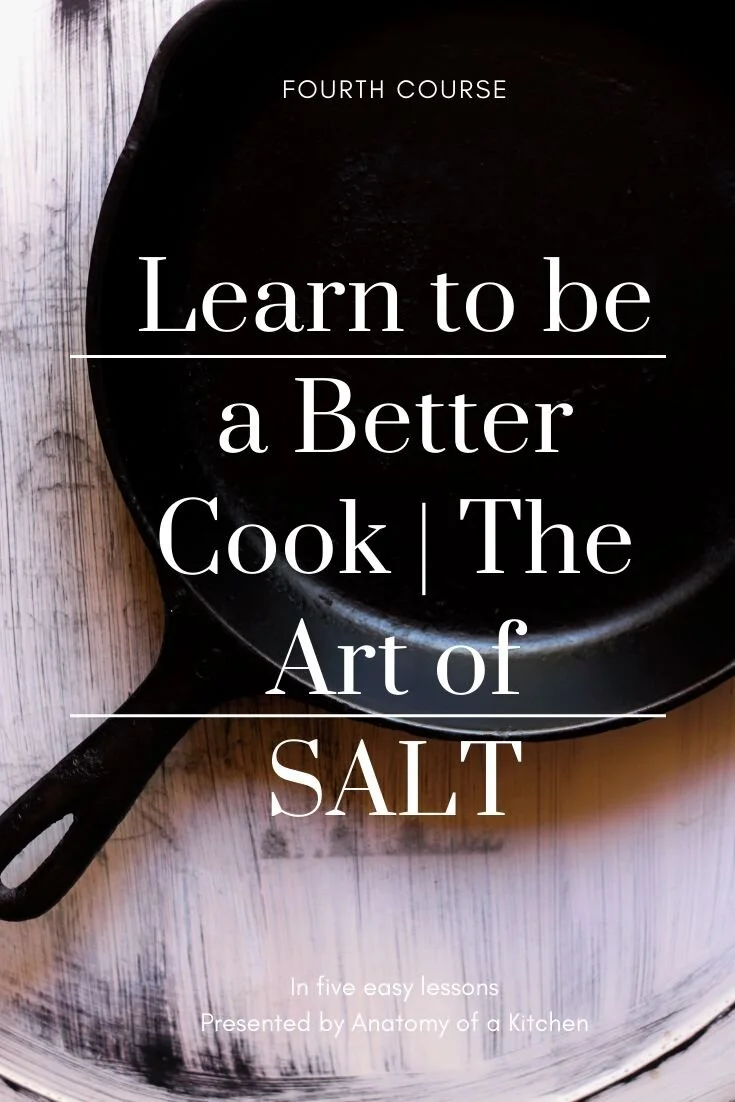Cooking Lessons | Session 4 | The Art of Salt
“One can tell a lot about a person by the company they keep, the books on their shelves & the food in their fridge”
Knowing how to properly season foods to make them appealing is a learned art that will come with time a & experience. But having a few versatile staples on hand is a stepping stone towards that goal. We begin this cooking lesson by giving you some general tips on how to infuse flavor into dishes. We finish the lesson by gifting you four beautiful printables to reference on your journey of becoming an intuitive cook.
Pro-Tip. Soups. Have you ever made a homemade soup & upon tasting, discovered that it was just missing something? Well here’s a pro tip for adjusting seasonings for soup. Often all that it needs is a few drops of tabasco or a squeeze of lemon. The tabasco I find, is best suited for brothy or tomato based soups whereas cream soups benefit from the fresh lemon. A splash of white wine or sherry can enlighten a sauce or soup. Sherry for instance serves to ‘open up the bouquet’ of clam or seafood chowder.
Fresh Sauces. We will be going over basic sauces (mother sauces such as marinara & bechamel) in lesson 5, our final lesson in this series. Today, lets discuss a couple fresh sauces that are extremely versatile; Chimichurri & Pesto. Both are, vibrant & herby. They are both fantastic with roasted meats. Prized by vegetarians & vegetable lovers alike for the wonderful earthy note they contribute to steamed or roasted vegetables. Pesto is delightful over hot pasta & chimichurri takes a plain bowl of rice to a new level. Trade up traditional red sauce for pesto on a pizza.
Chimichurri. A well oiled fresh herb sauce that originates from Argentina. It is most often used as a table condiment & served with roasted meats. Here is my recipe for chimichurri as well as a way to enjoy it. Mojo Steak with Chimichurri Sauce .
Pesto. An Italian mainstay. This sauce like chimichurri, is herby & rich. It general consists of basil, pine nuts, crushed garlic, & Parmesan blended with olive oil. It’s magic over hot pasta. Delightful on pizza. Drizzle into soups for a bright earthy bite. There are many other versions of pesto such as walnut & sage that are also delightful.
Infusing flavor into meats.
Marinade. To soak a food in a seasoned liquid in order to impart flavor & improve texture. There are three basic components to a marinade: Oil, Acid, flavoring. The ratio is 3/1. Three parts oil to one part acid. To make one cup of marinade you would use 3/4 cup oil to 1/4 cup of acid. This ratio applies to vinaigrettes as well. Here are two examples of a marinade at work Mojo Steak | Vegetable Rollentini & Marks Secret Marinade (the recipe is found towards the bottom of the page).
Oil- such as olive oil. Contributes to moisture retention. If a more neutral flavor is desired, then canola is a suitable oil to use.
Acid- such as lemon juice or vinegar. Serves to tenderize proteins & acts as a carrier for your herbs as well as imparting it’s own flavor.
Flavoring- add seasonings to create a distinctive flavor profile such as herbs, spices, salt, pepper, lemon zest.
Brine. A combination of water, sugar & salt often with other seasoning agents. A brine is an inexpensive & effortless way to add fantastic flavor to meats, improving the texture in the process. Most meats are brined overnight. Here is an example of a brine I used for chicken Lemon & Smoke Salt Brined Roasted Chicken. Below is a ratio of water/salt/sugar that works for most brines.
2 qts. Water.
1/4 cup Salt. Kosher salt, smoked salt, soy sauce.
3 Tbsp. Sugar. Turbinado, pure maple, honey.
Seasoning: 4- bay leaf/1 Tbsp. pepper corns/ 1 lemon slices/ 6 springs of lemon thyme
Dry Rub. A mixture of salt, herbs & spices that is worked into the surface of meat, chicken or fish. Sometimes oil or minced garlic is used in collaboration with a dry rub. This method is often used with barbequed meats. Here is an example of a dry rub I use for steak. Tri-Tip with a Smoky Dry Rub.
Your gift for joining us. Four printables to reference on your journey of becoming an intuitive cook.
There are endless ‘Well stocked Pantry’ lists out there to choose from. That is not the direction of this lesson . These are lists for the minimalist with a focus on quality. They are the essentials that I prize both in a professional setting & at home. When you click on the link below you will have access to all four. Thank you for joining us in our kitchen.
A list of our Favorite Cheeses.
Cooking with Fresh Herbs.
Essential Seasoning & Spices.
Favorite Pantry Essentials.
By clicking on the link below you will be added to our mailing list were we share recipes & kitchen tips. You may opt out at anytime.

